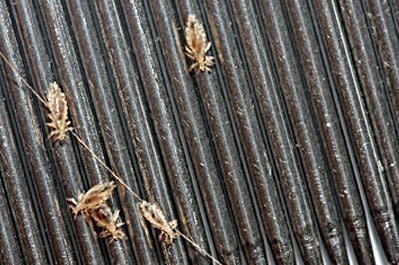Head lice: Overview
This magnified picture of head lice on a fine-tooth comb shows that these bugs are tiny.

The medical name for head lice is Pediculus humanus capitis
Having head lice does not mean you are dirty. Most people get head lice when they have head-to-head contact with someone who has head lice. Head-to-head contact lets the lice crawl from one head to another head. The lice do not care whether the person has squeaky-clean hair or dirty hair. The lice are looking for human blood, which they need to survive.
Millions of people get head lice each year. Head-lice infestations are especially common in schools. In the United States, it is believed that about 6 to 12 million children between 3 and 12 years of age get head lice each year.
Head lice are not known to spread disease, but having head lice can make your scalp extremely itchy. If you scratch a lot, it can cause sores on the scalp that may lead to an infection. Some people lose sleep because the itch is so intense.
Treatment, which most people can do at home, usually gets rid of head lice. If you have trouble getting rid of the lice or have an infection from scratching, you should see a dermatologist.
References
Canyon, DV, Speare R, et al. “Spatial and kinetic factors for the transfer of head lice (Pediculus capitis) between hairs.” J Invest Dermatol 2002; 119(3):629-631.
Frankowski BL, Bocchini JA. “Head Lice.” Pediatrics. 2010; 126(2):392-403.
Jacobson CC, Abel EA. “Parasitic infestations.” J Am Acad Dermatol 2007; 56(6):1026-1043.
Ko CJ, Elston DM. “Pediculosis.” J Am Acad Dermatol 2004; 50(1):1-12.
 Atopic dermatitis: More FDA-approved treatments
Atopic dermatitis: More FDA-approved treatments
 Biosimilars: 14 FAQs
Biosimilars: 14 FAQs
 How to trim your nails
How to trim your nails
 Relieve uncontrollably itchy skin
Relieve uncontrollably itchy skin
 Fade dark spots
Fade dark spots
 Untreatable razor bumps or acne?
Untreatable razor bumps or acne?
 Tattoo removal
Tattoo removal
 Scar treatment
Scar treatment
 Free materials to help raise skin cancer awareness
Free materials to help raise skin cancer awareness
 Dermatologist-approved lesson plans, activities you can use
Dermatologist-approved lesson plans, activities you can use
 Find a Dermatologist
Find a Dermatologist
 What is a dermatologist?
What is a dermatologist?